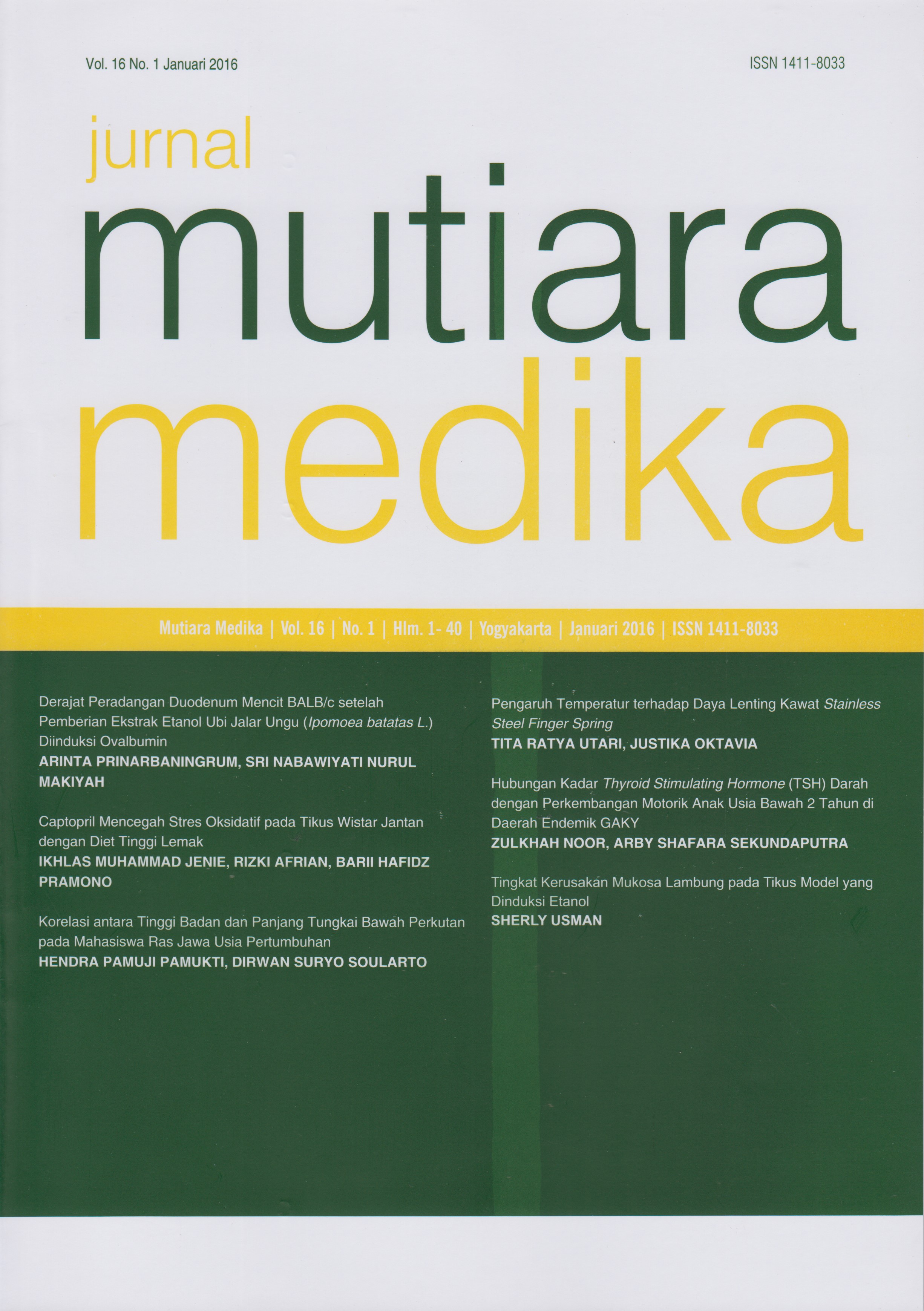Pengaruh Temperatur terhadap Daya Lenting Kawat Stainless Steel Finger Spring
DOI:
https://doi.org/10.18196/mmjkk.v16i1.4728Keywords:
Finger Spring, Daya Lenting, TemperaturAbstract
Alat ortodontik lepasan memiliki komponen aktif yang membantu menggerakkan gigi. Finger spring merupakan salah satu komponen aktif yang paling banyak digunakan yang dibuat dari kawat ortodontik stainless steel tipe austenitic dengan diameter 0,6 mm. Lingkungan rongga mulut dapat membuat kawat ortodontik mengalami kerusakan karena di dalam rongga mulut akan terkena paparan dari beberapa faktor seperti temperatur, saliva, plak, pH, protein dan makanan atau minuman. Tujuan dari penelitian ini adalah untuk mengetahui pengaruh temperatur terhadap daya lenting kawat stainless steel finger spring. Sampel yang digunakan dalam penelitian ini sebanyak 20 buah finger spring yang telah diaktifkan didalam plat akrilik dan terbagi menjadi 4 kelompok, yaitu kelompok 1 (kontrol) dimana finger spring diberi temperatur 37°C, kelompok 2 adalah kelompok dengan pemberian temperatur 15°C, kelompok 3 dengan pemberian temperatur 65°C, dan kelompok 4 dengan pemberian temperatur 15°C dan 65°C. Sebelum sampel diberi perlakuan, terlebih dahulu dilakukan pengukuran pre test daya lenting kemudian sampel diberi perlakuan temperatur selama 1 menit dalam sehari dan diulangi 7 minggu. Setelah selesai maka dilakukan pengukuran post test. Pengukuran daya lenting menggunakan tension gauge. Disimpulkan bahwa hasil uji statistik paired sampel t-test menunjukkan nilai (p<0,05) pada kelompok 2 dan 3 yang berarti memiliki perbedaan signifikan pada kelompok tersebut dan pada uji one way ANOVA menunjukkan nilai (p<0,05) yang berarti ada perbedaan yang signifikan dari setiap kelompok. Penurunan nilai daya lenting yang terjadi paling tinggi pada kelompok 3 diberi temperature 65°C.
References
2. Cobourne, MT & DiBiase, AT. Hand Book of Orthodontics. America: Mosby Elsevier. 2010.
3. Singht, G. Textbook of Orthodontic. Malaysia: Unipress Publishing. 2008.
4. Rondelli, G., Vicentini, B. Evaluation by Electrochemical Tests of the Passive Stability of Equiatomic Ni-Ti Alloy Also in Presence of Stress Induced Martensite. J Biomedical Material Res, 2000; 51: 47-54.
5. Sumarji. Studi Perbandingan Ketahanan Korosi Stainless Steel Tipe ss 304 dan ss 201 Menggunakan Metode U-Bend Test Secara
Siklik dengan Variasi Suhu dan ph. ROTOR, 2011; 4: 1–8.
6. Rasyid, NI, Pudyani, PS & Heryumani, J. Pelepasan Ion Nikel dan Kromium Kawat Australis Stainless Steel dalam Saliva Buatan. Dental Journal, 2014: 168.
7. Kapila, S. dan Sachdeva, R Mechanical Property and Clinical Application of Orthodontic Wire. Am. J.Ortod. Dentofac. Orthop, 1998; 96 (2): 100-109.
8. Pakshir, M., Bagheri, T. & Kazemi, M.R. In Vitro Evaluation of the Electrochemical Behaviour of Stainless Steel and Ni-Ti Orthodontic
Archwires at Different Temperatures. Eur J Orthod, 2013; 35 (4): 407-13.
9. Mardhani, I. & Harmami. Pengaruh Suhu terhadap Korosi Baja SS 304 dalam Media 1M HCL dengan Adanya Inhibitor Kinina. Jurnal Sains Dan Seni POMITS, 2013; 2 (2): C-76-78
10. House, K., Sernetz, F., Dymock, D., Sandi, J. & Ireland, A. Corrosion of Orthodontic Appliance-Should We Care? Am J Orthod Dentofacial Orthop, 2008; 133 (4): 584-92.
11. Ridwan, F. Basic Corrosion Engineering. Pekanbaru: Petroleum Engineering PT CPI. 1993.
12. Singer, F. L. & Andrew, P. Ilmu Kekuatan Bahan (Teori Kokoh Strenght of Material) edisi II, alih bahasa Dawin Sebayang. Jakarta: Erlangga. 1995.
13. Rucker, BK. & Kusy, RP. Elastic Flexural Properties of multistranded Stainless Steel Versus Conventional Nickel Titanium Archwires. Angle Orthodontic, 2002; 72 (4): 302-9.
Downloads
Issue
Section
License
Copyright
Authors retain copyright and grant Mutiara Medika: Jurnal Kedokteran dan Kesehatan (MMJKK) the right of first publication with the work simultaneously licensed under an Attribution 4.0 International (CC BY 4.0) that allows others to remix, adapt and build upon the work with an acknowledgment of the work's authorship and of the initial publication in Mutiara Medika: Jurnal Kedokteran dan Kesehatan (MMJKK).
Authors are permitted to copy and redistribute the journal's published version of the work (e.g., post it to an institutional repository or publish it in a book), with an acknowledgment of its initial publication in Mutiara Medika: Jurnal Kedokteran dan Kesehatan (MMJKK).
License
Articles published in the Mutiara Medika: Jurnal Kedokteran dan Kesehatan (MMJKK) are licensed under an Attribution 4.0 International (CC BY 4.0) license. You are free to:
- Share — copy and redistribute the material in any medium or format.
- Adapt — remix, transform, and build upon the material for any purpose, even commercially.
This license is acceptable for Free Cultural Works. The licensor cannot revoke these freedoms as long as you follow the license terms. Under the following terms:
Attribution — You must give appropriate credit, provide a link to the license, and indicate if changes were made. You may do so in any reasonable manner, but not in any way that suggests the licensor endorses you or your use.
- No additional restrictions — You may not apply legal terms or technological measures that legally restrict others from doing anything the license permits.






